Extracts from IPCC 4th Report Summary for Policymakers
IPCC 4th Report The Physical Science Basis
Working Group I to the IPCC 4th Report
1. Global atmospheric concentrations of carbon dioxide, methane and nitrous oxide have increased markedly as a result of human activities since 1750 and now far exceed pre-industrial values determined from ice cores spanning many thousands of years. The global increases in carbon dioxide concentration are due primarily to fossil fuel use and land-use change, while those of methane and nitrous oxide are primarily due to agriculture.
2. In this IPCC 4th Report The Physical Science Basis, the understanding of anthropogenic warming and cooling influences on climate has improved since the Third Assessment Report (TAR), leading to very high confidence that the globally averaged net effect of human activities since 1750 has been one of warming. The combined radiative forcing due to increases in carbon dioxide, methane, and nitrous oxide has increased, and its rate of increase during the industrial era is very likely to have been unprecedented in more than 10,000 years. The carbon dioxide radiative forcing increased by 20% from 1995 to 2005, the largest change for any decade in at least the last 200 years.
3. Warming of the climate system is unequivocal, as is now evident from observations of increases in global average air and ocean temperatures,widespread melting of snow and ice, and rising global mean sea level.

FIGURE above Observed changes in (a) global average surface temperature; (b) global average sea level rise from tide gauge (blue) and satellite (red) data and (c) Northern Hemisphere snow cover for March-April. All changes are relative to corresponding averages for the period 1961-1990. Smoothed curves represent decadal averaged values while circles show yearly values. The shaded areas are the uncertainty intervals estimated from a comprehensive analysis of known uncertainties (a and b) and from the time series (c).
4. The IPCC 4th Report The Physical Science Basis shows that at a continental, regional, and ocean basin scales, numerous long-term changes in climate have been observed. These include changes in Arctic temperatures and ice, widespread changes in precipitation amounts, ocean salinity, wind patterns and aspects of extreme weather including droughts, heavy precipitation, heat waves and the intensity of tropical cyclones.
5. Paleoclimate information supports the interpretation that the warmth of the last half century is unusual in at least the previous 1300 years. The last time the polar regions were significantly warmer than present for an extended period (about 125,000 years ago), reductions in polar ice volume led to 4 to 6 metres of sea level rise.
6. Analysis of climate models together with constraints from observations enables an assessed likely range to be given for climate sensitivity for the first time and provides increased confidence in the understanding of the climate system response to radiative forcing.
7. For the next two decades a warming of about 0.2°C per decade is projected for a range of SRES emission scenarios. Even if the concentrations of all greenhouse gases and aerosols had been kept constant at year 2000 levels, a further warming of about 0.1°C per decade would be expected.

FIGURE above from the IPCC 4th Report The Physical Science Basis shows comparison of observed continental- and global-scale changes in surface temperature with results simulated by climate models using natural and anthropogenic forcings. Decadal averages of observations are shown for the period 1906–2005 (black line) plotted against the centre of the decade and relative to the corresponding average for 1901–1950. Lines are dashed where spatial coverage is less than 50%. Blue shaded bands show the 5–95% range for 19 simulations from 5 climate models using only the natural forcings due to solar activity and volcanoes. Red shaded bands show the 5–95% range for 58 simulations from 14 climate models using both natural and anthropogenic forcings.
8. In the IPCC 4th Report The Physical Science Basis, there is now higher confidence in projected patterns of warming and other regional-scale features, including changes in wind patterns, precipitation, and some aspects of extremes and of ice.
9. Anthropogenic warming and sea level rise would continue for centuries due to the timescales associated with climate processes and feedbacks, even if greenhouse gas concentrations were to be stabilized.
 FIGURE above Projected surface temperature changes for the early and late 21st century relative to the period 1980–1999. The central and right panels show the Atmosphere-Ocean General Circulation multi-Model average projections for the B1 (top), A1B (middle) and A2 (bottom) SRES scenarios averaged over decades 2020–2029 (center) and 2090–2099 (right). The left panel shows corresponding uncertainties as the relative probabilities of estimated global average warming from several different AOGCM and EMICs studies for the same periods. Some studies present results only for a subset of the SRES scenarios, or for various model versions. Therefore the difference in the number of curves, shown in the left-hand panels, is due only to differences in the availability of results.
FIGURE above Projected surface temperature changes for the early and late 21st century relative to the period 1980–1999. The central and right panels show the Atmosphere-Ocean General Circulation multi-Model average projections for the B1 (top), A1B (middle) and A2 (bottom) SRES scenarios averaged over decades 2020–2029 (center) and 2090–2099 (right). The left panel shows corresponding uncertainties as the relative probabilities of estimated global average warming from several different AOGCM and EMICs studies for the same periods. Some studies present results only for a subset of the SRES scenarios, or for various model versions. Therefore the difference in the number of curves, shown in the left-hand panels, is due only to differences in the availability of results.
Material on this page has been extracted from the IPCC 4th Report, The Physical Science Basis.
